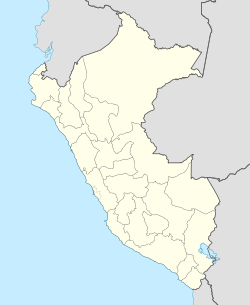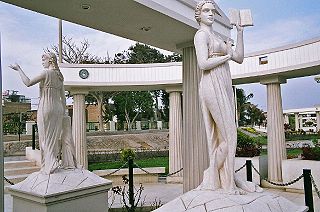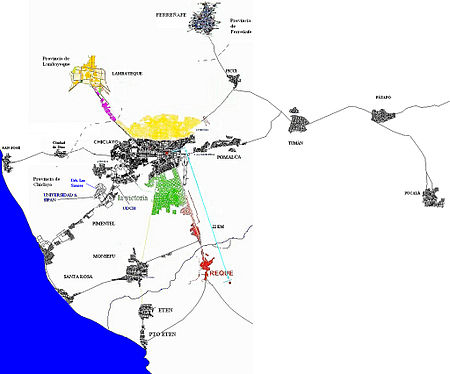- Chiclayo
-
Chiclayo Chiclayo's main square
Coat of armsNickname(s): City of Friendship Location in Peru Coordinates: 6°45′46.66″S 79°50′11.81″W / 6.7629611°S 79.8366139°W Country  Peru
PeruRegion Lambayeque Region Province Chiclayo Province Settled 16th century Government - Mayor Roberto Torres Gonzales Area - City 6.211 km2 (2.4 sq mi) Elevation 27 m (89 ft) Population - Urban 738,000 - Metro 972,713 (2,009) Time zone PET (UTC-5) ZIP code(s) 14000-14013 Area code(s) 74 Website www.gobiernochiclayo.gob.pe Chiclayo (Spanish pronunciation: [tʃiˈklaʝo]) is the capital city of the Lambayeque region in northern Peru. It is located 13 kilometers inland from the Pacific coast and 770 kilometers from the nation's capital, Lima. As of 2011, Chiclayo is the fourth most populous city in Peru with a population of 629,990 (comprising 6 contiguous urban districts: Chiclayo, José Leonardo Ortiz, La Victoria, Pomalca, Reque and Pimentel) and the third largest metropolitan area of Perú.
Founded by Spanish explorers as "Santa María de los Valles de Chiclayo" in the 16th century, it was declared a city on 15 April 1835 by president Felipe Santiago Salaverry. He named Chiclayo "the Heroic City" to recognize the courage of its citizens in the fight for independence, a title it still holds. Other nicknames for Chiclayo include "The Capital of Friendship" and the "Pearl of the North".
Currently, Chiclayo is one of the most important urban areas of Peru. It is now the country's fourth-largest city, after Lima, Arequipa, and Trujillo. The city has a population of 738,000,[1] while the metropolitan area has a population of 972,713 (2009 - World-Gazetteer.com).
The city was founded near an important prehistoric archaeological site, the Northern Wari ruins, which constitute the remains of a city from the 7th-12th century Wari Empire.
Contents
Etymology
Many different historical accounts tell of the naming of Chiclayo. Some attribute it to an indigenous man known as "chiclayoc" or "chiclayep" who transported plaster between the ancient cities of Zaña, Lambayeque and Morrope.
Another version claims that around the time that the city was founded, the area was home to a green-colored fruit called chiclayep or chiclayop which in the Mochican language means "green that hangs". In some towns in the highlands of Cajamarca, squashes are known as chiclayos, evidence that this fruit is the origin of the city's name.
Another source indicates that the word is a translation from the extinct Moche language and is derived from the word Cheqta which means "half" and yoc which means "property of".
Others say the Mochican language had words similar to the name, such as Chiclayap or Chekliayok, which means "place where there are green branches".
History
Pre-Columbian cultures
Mochica culture
Main article: MocheThe 'Moche civilization existed from the years A.D. 100 to A.D. 800, occupying the territory which is now the northern coast of Peru in the Ancash, Lambayeque, and La Libertad regions of Peru. The area of current-day Chiclayo was part of this civilization.
This culture had a high understanding of hydraulic engineering as manifested by their canal system which allowed them to use rivers to irrigate their land. This allowed them to have a surplus of crops and a solid economy allowing their society to develop. The Mochicans also used copper in the fabrication of weapons, tools, and ornamental objects.
The Mochicans are considered the producers of the best ceramic artifacts because of the elaborate designs of the pottery. These designs represent religious themes, humans, animals, and scenes of ceremonies and myths reflecting their perception of the world. They are noted for their expressiveness, perfection, and realism.
Lambayeque Culture
Main article: Lambayeque cultureThe Lambayeque culture or Sican existed between the years A.D. 700 to A.D. 1375 and occupied the territory of the current-day department of Lambayeque. The area near the current-day city of Chiclayo was part of the Lambayeque civilization.
This culture was formed towards the end of the Moche civilization assimilating much of their knowledge and cultural traditions.
The Lambayeque culture's civilization was divided into three phases or stages:
- Early stage (700–900)
- Intermediate stage (900–1100)
- Late stage (1100–1350)
The Lambayeques excelled in architecture, goldsmithing, and navigating.
Colonial period
In the early 16th century, Chiclayo was inhabited by two ethnic groups; the Cinto and Collique. The cheiftans of these ethnic groups donated part of their land for the construction of a Franciscan convent. This cesion of land was approved by the royal decree of 17 September 1585. Thus, with the advocation of Saint Maria of Chiclayo and under the direction of Father Fray Antonio of the Concepción, a church and a Franciscan covenant were erected at Chiclayo. At the time of construction of these Spanish-built edifices, the city of Chiclayo was founded.
Chiclayo, unlike most other Peruvian colonial cities such as Lima, Piura, Trujillo, or Arequipa, was inhabited by a largely indigenous population rather than Spanish colonizers. On 15 April 1835, during the republican era, the urbanization of Chiclayo was elevated to the category of city by the then president Felipe Santiago Salaverry. That same day, Chiclayo received the title of "Heroic City". The next day the Chiclayo Province is created of which Chiclayo becomes the capital.
Republican era
During the Peruvian War of Independence Chiclayo was not indifferent to the patriot revolutionary cause, and supported it by suppling soldiers, weapons, horses, and other important resources to General José de San Martín's liberating army. All of this came to be under the supervision of the most progressive creole, José Leonardo Ortiz.
Soon after independence Chiclayo was still a small village. Nevertheless, due to its strategic geographic location, in future decades it became a rail, communications, and automotive hub. In 1827, Chiclayo was elevated to the level of villa. The progress of Chiclayo is evident in the early republican era by the naming of Chiclayo as a "Heroic City" in recognition of the services rendered by the Chiclayan people in the Peruvian War of Independence.
Geography
Climate
Chiclayo has a warm and very dry desert climate with the sun shining all year around.
Chiclayo Climate chart (explanation) J F M A M J J A S O N D 5291933020103020528193261802417023160231502315024163251602717Average max. and min. temperatures in °C Precipitation totals in mm Source: The Weather Channel (in Portuguese) Imperial conversion J F M A M J J A S O N D 0.284660.186680.486680.282660.1796407563073610735907359075610.1776108163Average max. and min. temperatures in °F Precipitation totals in inches Transportation
Air
Main article: Cap. FAP José A. Quiñones Gonzales International AirportThe city is served by the Cap. FAP José A. Quiñones Gonzales International Airport, which houses primarily domestic airlines, chartered international flights, and fuel supply services. The terminal has a runway of 2520 by 45 square meters.
There are currently four airlines that serve Chiclayo's international airport, some of which who offer daily service and others interdaily service. There are two schedules for this service one morning schedule and one afternoon schedule. There are flights to the city of Tumbes and especially to the city of Iquitos. The US-based Spirit Airlines has expressed interest in serving Chiclayo from its hub in Fort Lauderdale, Florida, USA.
Land
Chiclayo, because of its location, serves as a point of interconnection for various cities of the Northeast of the country and has various bus companies which service cities such as Lima, Trujillo, Piura, Cajamarca, Chota, Cutervo, Bagua, Jaén, Chachapoyas, and Tumbes.
To adequately accommodate the transportation demand, the city is served by two different land terminals, one located towards the southern end of the city and another at the northern end on the Panamerican Highway.
A substantial number of bus companies have their own terminals, many of them located near the downtown of the city and in nearby areas. These interprovincial buses contribute to the congestion experienced in downtown Chiclayo. To try to solve the problem the city government has proposed a plan to build a central station in the city.
Regionally, there are various different public services such as combis, cousters, colectivos, which provide services within the districts and provinces of the department of Lambayeque.
Population
According to the Census of Population and Housing undertaken in 2007, 574.408 people inhabit the area within Chiclayo's cities limits or the six municipalities. The metropolitan area has a population of 930.824; it includes other nearby cities like Monsefú and Lambayeque in a ten minutes ratio by paved highway. Under the thirty minutes range are, in order of hierarchy, Ferreñafe, Santa Rosa, Eten, Illimo and Tuman. Chiclayo is at the center of Chancay River delta, in a fertile valley.
Municipalities of
the cityArea
km²Population
(census 2007)Households
(2007)Density
(hab/km²)Elevation
msnmDistance from
main square(km)Chiclayo center 50.35 260,948* 60,325 5,182.7 27 0 km José Leonardo Ortiz 28.22 167,717* 34,641 5,943.2 28 1.5 km La Victoria 29.36 77,699* 16,447 2,646.4 23 2.4 km Pomalca 80.35 23,092* 5,802 287.39 29 7 km Reque 47.03 12,606* 3,664 268.04 21 8 km Pimentel 66.53 32,346* 9,301 486.2 4 11.9 km Total 301.84 km2 574,408* 130,180 1,903.02 — — *Data from the census taken by the INEI[2] According to the planning director of Chiclayo, by 2020 the San Jose district belonging to the Lambayeque Province will be completely integrated with the city of Chiclayo. The district currently has a population 12.156 inhabitants. Currently most of the district is conurbanized with the rest of Chiclayo.
Education and Culture
The following is a list of the universities located in Chiclayo:
- Catholic University of Santo Toribio de Mogrovejo
- Señor de Sipan University
- Private University of Chiclayo
- University of Lambayeque
- San Martín de Porres University Campus
- César Vallejo University Campus
- Alas Peruanas University Campus
- Federal Republic of Germany Institute
- Pedro Ruiz Gallo National University is not in Chiclayo but in near Lambayeque city, 11 km distance.
The following is a list of museums in the area:
- Huaca Rajada - Sipan Museum
- Royal Tombs of Sipan Museum
- Sican National Museum
- Hans Heinrich Bruning National Museum
- Museum of Valley of the Pyramids of Tucume
- On Site Museum in Sipán is the newest and the smaller
Tourist attractions of Lambayeque
Main article: Tourism in Peru#Destinations by Department#LambayequeFamous persons from Chiclayo
- José Quiñones Gonzáles National aviation hero
- Augusto Bernardino Leguía y Salcedo Presidenf of Perú (1908–1912 / 1919–1930)
- Luis Castaneda Lossio Mayor of Lima (2005–2010)
- Yehude Simons Munaro Former Minister leader of the cabinet
- Lucila Boggiano de Zoeger Mrs. World 1989
- Viviana Rivasplata Model and beauty queen
- Miguel Baca Rossi Sculptor
- Alejandra Davila Princess
- Elías Aguirre Navy hero, second commander aboard "Huáscar" in 1879
- Eduardo Orrego Villacorta Architect
- Juan Mejia Baca Books Editor, National Library Director
- Velásquez Quesquén Lawyer & politician; presided Congress and was Head of Cabinet in 2009-10
- Carlos Eduardo Samamé Quiñones Commander-in-Chief Peruvian Air Force
- Tania Libertad International Singer
Bibliography
- Guía metropolitana ,comercial, industrial y estadística de la ciudad de Chiclayo. Ciudad Comercial del Norte peruano. Chiclayo, 2002, incluye un croquis de la ciudad de Chiclayo.
- Diario la industria de Chiclayo.suplemento dominical.-Comentarios de la actualización del plan regulador "Chiclayo 2020"
- "Ponencia: "Hacia una ciudad sostenible", Ex alcalde de Chiclayo Dr.Arturo Castillo Chirinos.
- "Ciudad Heroica" Columna del diario El correo de Chiclayo.Dr. Fernando Bartra Grosso.
- " Modernización de Chiclayo ha comenzado" Jorge Incháustegui Samamé. enlace del catatro Sach.
- "Historia de la ciudad de Reque" Ministerio evangelistico nueva vida. Dante Samillán Rodriguez .
- "Planificacion y desarrollo de la ciudad de Chiclayo metropolitano". prolongación al sur de la ciudad,-historia de Reque en la ciudad de Chiclayo-, -creación del distrito de la victoria. Dante Samillán Rodriguez.
- "Futuro de Chiclayo, encuentro económico APEC, mejoramiento de la ciudad de chiclayo". diario la industria.
- ALCALDE, Nélida. Los tugurios en el centro urbano de Chiclayo, 1940–1970. TLS/UNPRG, Lambayeque, 1984.
- BAZÁN, Inés y José GÓMEZ. Capitalismo y región en Lambayeque. Instituto de Estudios Sociales Naymlap, Chiclayo, 1983, 125 pp.
- CARDOSO, César. "El poder económico en Lambayeque". En: Dominical, Suplemento de La Industria, Chiclayo, domingo 5 de marzo de 1995, pp. 4-5.
- BACHMANN, Carlos J. Departamento de Lambayeque. Monografía Histórico - Geográfica.
- ASENJO MUNDACA, Clara; SANTA CRUZ ROJAS, Hilda R. Educación y crisis en el distrito de La Victoria 1987–1994. TLS/UNPRG, Lambayeque, 1994.
- ALVARADO, D. y F. EFFIO. Desarrollo urbano de la ciudad de Chiclayo 1875–1981. TLS, UNPRG, Lambayeque, 1984.
- Plan director 2020 y catastro urbano de la ciudad de Chiclayo.
References
- ^ "Local Stats, Info, Weather", TravelsRadiate, Aug 3, 2011, accessed Aug 3, 2011.
- ^ INEI Census 2007
 Peruvian cities with a population of over 100,000
Peruvian cities with a population of over 100,000Coordinates: 6°45′46.66″S 79°50′11.81″W / 6.7629611°S 79.8366139°W
Categories:- Cities in Peru
- Populated places in the Lambayeque Region
- Populated places established in 1560
Wikimedia Foundation. 2010.







